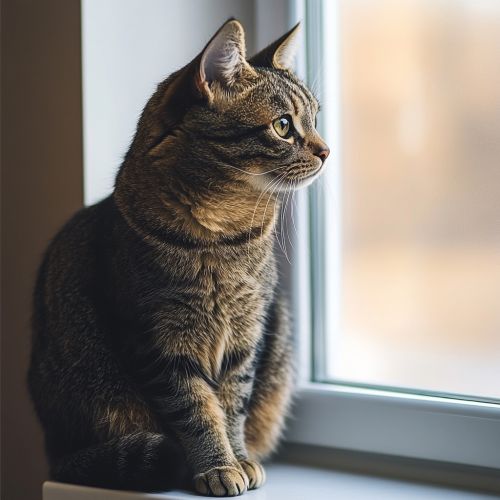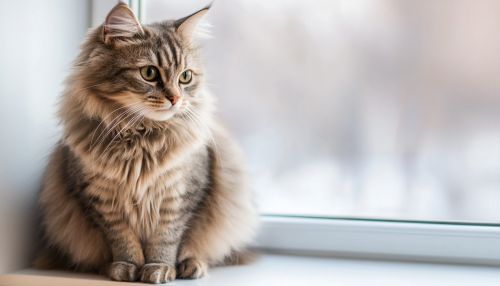Cat: Difference between revisions
(Created page with "== Introduction == The domestic cat (''Felis catus'') is a small, typically furry, carnivorous mammal. They are often valued by humans for companionship and their ability to hunt vermin. Cats are similar in anatomy to the other felids, with strong, flexible bodies, quick reflexes, sharp retractable claws, and teeth adapted to killing small prey. They are known for their agility and stealth. == Taxonomy and Evolution == Cats belong to the family Felidae, which is part...") |
No edit summary |
||
| (One intermediate revision by the same user not shown) | |||
| Line 34: | Line 34: | ||
* **Touch**: Cats have sensitive whiskers (vibrissae) that detect changes in their environment and help them navigate in the dark. | * **Touch**: Cats have sensitive whiskers (vibrissae) that detect changes in their environment and help them navigate in the dark. | ||
[[Image:Detail-98199.jpg|thumb|center|Domestic cat sitting on a windowsill, looking outside.|class=only_on_mobile]] | |||
[[Image:Detail-98200.jpg|thumb|center|Domestic cat sitting on a windowsill, looking outside.|class=only_on_desktop]] | |||
== Behavior == | == Behavior == | ||
Latest revision as of 18:24, 8 October 2024
Introduction
The domestic cat (Felis catus) is a small, typically furry, carnivorous mammal. They are often valued by humans for companionship and their ability to hunt vermin. Cats are similar in anatomy to the other felids, with strong, flexible bodies, quick reflexes, sharp retractable claws, and teeth adapted to killing small prey. They are known for their agility and stealth.
Taxonomy and Evolution
Cats belong to the family Felidae, which is part of the order Carnivora. The domestic cat is a member of the genus Felis, which includes small cats such as the wildcat and the sand cat. The domestic cat's closest relatives are the African wildcat (Felis lybica), the European wildcat (Felis silvestris), and the Asiatic wildcat (Felis ornata).
The domestication of cats is believed to have begun around 9,500 years ago in the Near East. Genetic studies suggest that domestic cats are descended from the African wildcat. Cats were likely attracted to human settlements by the abundance of rodents, and over time, a mutually beneficial relationship developed.
Anatomy and Physiology
Cats have a highly specialized anatomy that allows them to be effective hunters. They have a flexible spine, powerful hind legs, sharp retractable claws, and keen senses.
Skeletal System
The cat's skeleton is composed of approximately 230 bones, which is more than humans. This includes a flexible spine and a tail that helps with balance. The cat's skull is short and rounded, with large eye sockets and a powerful jaw.
Muscular System
Cats possess a highly developed muscular system that allows for quick and precise movements. Their powerful hind legs enable them to leap great distances, while their forelimbs are adapted for grasping and holding prey.
Digestive System
Cats are obligate carnivores, meaning they require a diet primarily of meat. Their digestive system is adapted to process animal protein and fat efficiently. They have a relatively short gastrointestinal tract, which is typical of carnivores.
Sensory Organs
Cats have highly developed senses that aid in hunting and navigation.
- **Vision**: Cats have excellent night vision due to a high number of rod cells in their retinas and a reflective layer behind the retina called the tapetum lucidum.
- **Hearing**: Cats have acute hearing and can detect a wide range of frequencies, including ultrasonic sounds made by rodents.
- **Smell**: Cats have a highly developed sense of smell, which they use to detect prey and communicate with other cats.
- **Touch**: Cats have sensitive whiskers (vibrissae) that detect changes in their environment and help them navigate in the dark.


Behavior
Cats exhibit a wide range of behaviors that are influenced by their environment, genetics, and experiences.
Social Structure
Cats are generally solitary animals, but they can form social groups, especially in environments where resources are abundant. In such groups, a hierarchy is often established, with dominant individuals having priority access to resources.
Communication
Cats communicate through a combination of vocalizations, body language, and scent marking. Common vocalizations include meowing, purring, hissing, and growling. Body language, such as tail position and ear orientation, conveys a cat's mood and intentions. Scent marking involves rubbing their face and body against objects or spraying urine to establish territory.
Hunting and Feeding
Cats are natural hunters and exhibit a range of hunting behaviors, including stalking, pouncing, and capturing prey. They are crepuscular, meaning they are most active during dawn and dusk. Domestic cats often bring captured prey to their owners, which is believed to be a form of social bonding.
Reproduction and Lifespan
Cats reach sexual maturity between 5 to 10 months of age. Female cats (queens) are polyestrous, meaning they can go into heat multiple times a year. The gestation period for cats is approximately 63-65 days, and litters typically consist of 2-5 kittens.
Kittens are born blind and helpless, relying on their mother for warmth and nourishment. They begin to open their eyes at around 7-10 days old and start to explore their environment at about 3 weeks of age. Weaning occurs at around 6-8 weeks, and kittens are usually fully independent by 12 weeks.
The average lifespan of a domestic cat is around 12-15 years, although some cats can live into their 20s with proper care.
Health and Diseases
Cats are susceptible to a variety of health issues, including infectious diseases, parasites, and chronic conditions.
Common Infectious Diseases
- **Feline Immunodeficiency Virus (FIV)**: A virus that weakens the immune system, making cats more susceptible to other infections.
- **Feline Leukemia Virus (FeLV)**: A virus that can cause cancer and suppress the immune system.
- **Feline Panleukopenia**: A highly contagious viral disease that affects the gastrointestinal tract and immune system.
Parasites
Cats can be affected by both external and internal parasites.
- **External Parasites**: Fleas, ticks, and mites are common external parasites that can cause discomfort and transmit diseases.
- **Internal Parasites**: Worms, such as roundworms, hookworms, and tapeworms, can infect the gastrointestinal tract and cause various health issues.
Chronic Conditions
- **Chronic Kidney Disease (CKD)**: A common condition in older cats that affects kidney function.
- **Diabetes Mellitus**: A condition where the body cannot properly regulate blood sugar levels.
- **Hyperthyroidism**: An overproduction of thyroid hormones, leading to increased metabolism and other health issues.
Genetics and Breeding
Cats have a diverse genetic makeup, which has led to the development of numerous breeds with distinct physical and behavioral traits.
Cat Breeds
There are over 70 recognized cat breeds, each with unique characteristics. Some popular breeds include:
- **Siamese**: Known for their slender bodies, blue eyes, and vocal nature.
- **Persian**: Characterized by their long fur and flat faces.
- **Maine Coon**: One of the largest domestic cat breeds, known for their friendly and sociable nature.
- **Sphynx**: A hairless breed with a distinctive appearance and affectionate personality.
Genetic Disorders
Certain breeds are predisposed to specific genetic disorders due to selective breeding practices.
- **Polycystic Kidney Disease (PKD)**: Common in Persian and related breeds.
- **Hypertrophic Cardiomyopathy (HCM)**: A heart condition prevalent in Maine Coons and Ragdolls.
- **Progressive Retinal Atrophy (PRA)**: An eye disorder that can lead to blindness, seen in Abyssinians and Siamese.
Human-Cat Relationship
Cats have been associated with humans for thousands of years, serving various roles from pest control to companionship.
Historical Significance
Cats have held cultural and religious significance in various societies. In ancient Egypt, cats were revered and often depicted in art and mythology. They were associated with the goddess Bastet, who represented home, fertility, and protection.
Modern Role
Today, cats are one of the most popular pets worldwide. They provide companionship and emotional support to millions of people. Cats are also used in therapy and as service animals in some cases.
Conservation and Welfare
While domestic cats are not at risk of extinction, their presence can impact local wildlife populations. Feral cats, in particular, can pose a threat to native species.
Feral Cats
Feral cats are domestic cats that have reverted to a wild state. They live independently of human care and often form colonies. Efforts to manage feral cat populations include trap-neuter-return (TNR) programs, which aim to reduce the number of feral cats humanely.
Animal Welfare
Ensuring the welfare of domestic cats involves providing proper nutrition, healthcare, and a stimulating environment. Responsible pet ownership includes spaying or neutering to prevent overpopulation and regular veterinary check-ups to maintain health.
